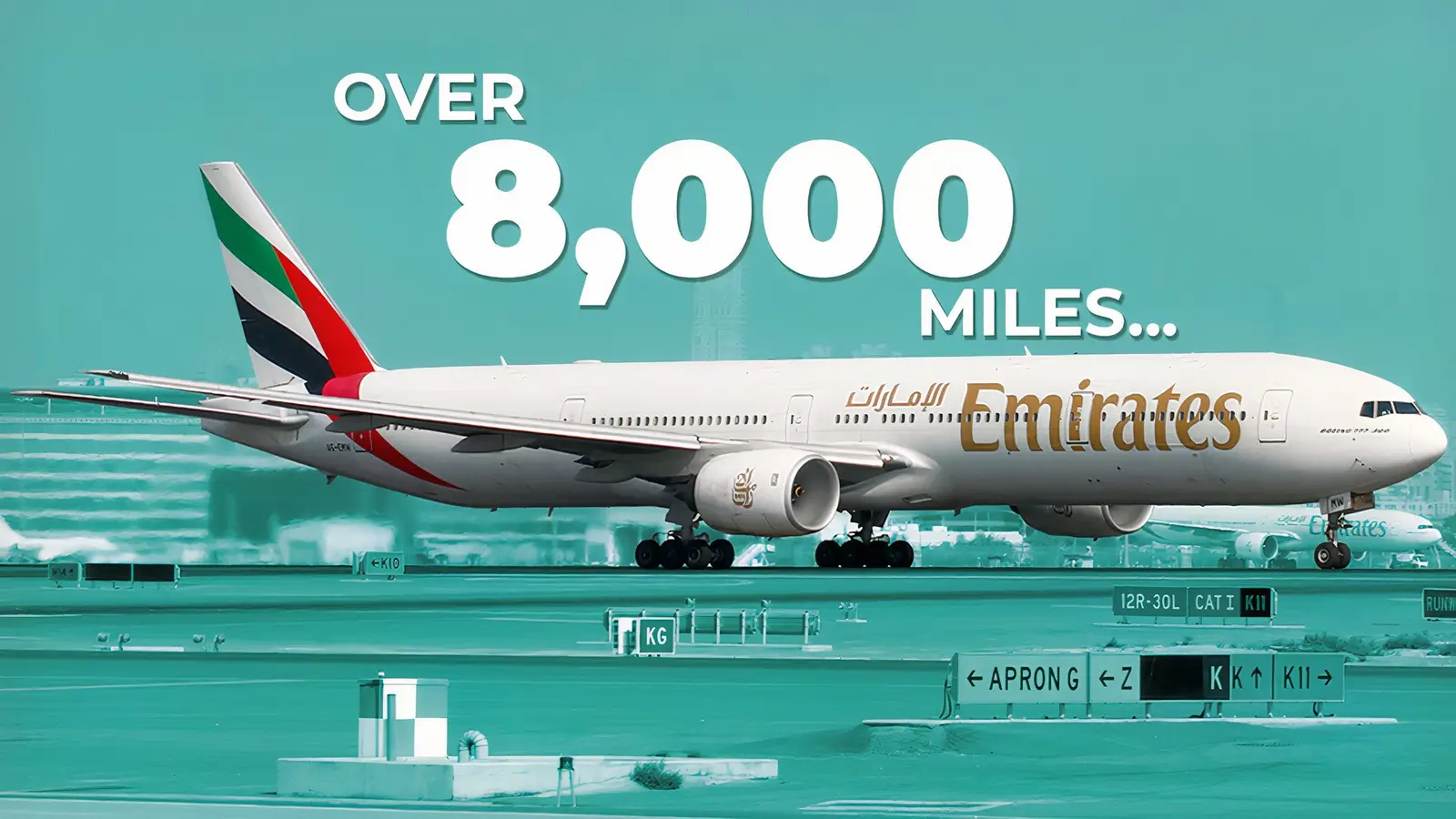
Emirates remains one of the world’s largest operators of the Boeing 777, and, in 2025, the twinjet continues to play a defining role in the carrier’s network. While the Airbus A380 often captures the spotlight as Emirates’ flagship, the 777 remains the workhorse of the airline. With its versatility, range, and reliability, the 777 serves destinations where the superjumbo would be either too large or operationally impractical.
Today, Emirates operates multiple variants of the Triple-Seven for different routes and reasons. It flies the Boeing 777-200LR, Boeing 777F, and Boeing777-300ER, although the latter is by far the most prominent in its fleet. These aircraft enable Emirates to reach secondary markets as well as central hubs, often covering routes stretching over 8,000 miles.
The Boeing 777 Fleet At Emirates
Emirates operates the world’s largest Boeing 777 fleet, with over 140 active aircraft in 2025. The bulk of this fleet consists of the 119 777-300ERs, a long-haul variant capable of seating more than 350 passengers in typical configurations. Alongside these, the airline also has a smaller number of 777-200LRs, which were primarily introduced to cover ultra-long-haul missions such as from Dubai to the United States.
The airline has used the 777 extensively for more than two decades, steadily building a global network in which the aircraft is a backbone asset. The 777’s flexibility means it is equally comfortable flying shorter missions to South Asia as it is traversing transoceanic routes to North America or Australia. While Emirates is gradually preparing for the arrival of the next-generation 777X, its current fleet continues to drive much of the carrier’s daily operations.
According to data from Cirium, an aviation analytics company, Emirates has deployed the Boeing 777 on routes that generate billions of available seat miles annually. These routes are especially important where the Airbus A380 cannot be justified, such as secondary US cities or thinner Oceania markets.
The Destinations In North America
The United States represents one of the most important regions for Emirates’ Boeing 777 operations. The airline connects Dubai to several American cities with flights that stretch well beyond 7,000 miles (11,000 km), utilizing the 777’s long-range capabilities.
Dubai To Dallas/Fort Worth. This route is Emirates’ longest non-stop 777 service, covering 8,038 miles (12,936 km). It operates 366 times per year, providing 120,320 seats and generating 967 million ASMs. Dallas’s role as a logistics and aviation hub makes this one of Emirates’ most strategic US routes. Notably, Qatar Airways also operates flights from Doha to Dallas, creating strong Gulf competition in this long-haul sector.
Dubai To Miami. At 7,844 miles (12,624 km), the DXB–MIA route is the second-longest 777 service. With 366 flights annually, it produces over 955 million ASMs. Miami’s strong Latin American connections make it a natural fit for Emirates’ global network. Etihad Airways, operating out of nearby Abu Dhabi, has not yet launched services to Miami, but Qatar Airways offers competition via Doha.
Dubai To Orlando. Orlando ranks third among Emirates’ US 777 routes, spanning 7,754 miles (12,479 km). With 261 flights annually and more than 92,000 seats, this leisure-focused service capitalizes on Florida’s role as a tourism hub. Currently, Emirates has little direct competition for this specific city-pair, which makes Orlando unique compared to Miami or New York.
Dubai To Seattle. Seattle’s route stretches 7,425 miles (11,949 km), operating 366 times annually with nearly 895 million ASMs generated. The Pacific Northwest’s technology and aerospace industries make it a valuable link for Emirates. Delta Air Lines has historically offered one-stop services to the Middle East via European partners, but Emirates’ nonstop option remains unmatched for convenience.
Dubai To Chicago. Chicago O’Hare sits at 7,246 miles (11,661 km) from Dubai and receives 366 flights annually. With 118,548 seats and 859 million ASMs, it is one of the strongest 777 operations in the Midwest. Etihad also serves Chicago from Abu Dhabi, meaning travelers from the UAE have multiple Gulf carrier options for reaching the Windy City.
Dubai To Boston. Finally, the Boston connection covers 6,663 miles (10,723 km), providing 120,028 seats annually across 366 flights. With 799 million ASMs, the route serves New England’s academic, biotech, and business communities. Qatar Airways is also a competitor, operating its own Doha–Boston service, while Emirates maintains a strong nonstop product from Dubai.
Emirates also offers several flights to Canada, including a non-stop service from Dubai to Montréal on both the Boeing 777-300ER and 777-200LR. However, these routes are slightly shorter due to the North Pole route via Russia that Emirates uses. Therefore, no single city in Canada is included in the top ten longest routes.
The Destinations In South America
South America remains a challenging market for long-haul carriers, but Emirates has managed to establish a presence in Brazil. The Boeing 777 operates one of the airline’s longest flights to the region, namely from Dubai to Rio de Janeiro. At 7,383 miles (11,882 km), the DXB–GIG route is Emirates’ key 777 link to South America.
It operates 280 times annually, offering nearly 100,000 seats and producing 734 million ASMs. This service complements Emirates’ São Paulo flights operated with an Airbus A380, while extending the airline’s reach into Brazil’s cultural capital. Qatar Airways and Turkish Airlines also serve South America extensively, with flights to São Paulo and Buenos Aires, highlighting the competition Gulf and European carriers face in this long-haul market.
The Destinations In Australia
Australia is a cornerstone of Emirates’ international network, serving as a major connecting hub for travelers between major European and Australian cities. The Boeing 777 plays an essential role in serving several major cities across the continent. Emirates also offers direct flights to neighboring New Zealand, which is further away, but an Airbus A380 is currently used for these flights.
Dubai To Brisbane. Spanning 7,442 miles (11,977 km), this route is a vital link in Oceania. With 68 annual flights, it produces almost 179 million ASMs. Though less frequent than Sydney or Melbourne, Brisbane adds depth to Emirates’ Australian offering. Etihad also flies to Brisbane from Abu Dhabi, while Qatar Airways has established its own presence with flights from Doha to Brisbane.
Dubai To Melbourne. Melbourne, at 7,230 miles (11,636 km), is served 278 times annually by the 777. With 90,080 seats offered, the route generates 651 million ASMs, reflecting Melbourne’s importance as Australia’s cultural hub. Melbourne also sees services from Qatar Airways, Etihad, and Singapore Airlines, making it one of the hottest long-haul markets in Oceania.
Dubai To Adelaide. The Adelaide connection covers 6,834 miles (10,998 km), with 334 flights annually. Offering more than 100,000 seats and generating 689 million ASMs, this route ensures that South Australia is directly tied to the Middle East. Adelaide is less frequently served by Gulf rivals, giving Emirates a market exclusivity advantage.
Why These Routes Matter
Emirates’ reliance on the Boeing 777 for ultra-long-haul services underscores the aircraft’s adaptability and economic efficiency. These flights connect Dubai to diverse markets, from US technology hubs to South American cultural centers and Australian metropolises.
These routes also highlight Emirates’ strategy of diversification, ensuring connectivity beyond the traditional superjumbo routes. Beyond passengers, Emirates’ Boeing 777 network also transports a significant amount of cargo. The belly capacity of the 777-300ER is crucial for industries ranging from pharmaceuticals to electronics, especially on US routes where high-value goods are shipped both ways.
Routes like Dallas/Fort Worth and Chicago, which are connected to the logistics and manufacturing sectors, see steady cargo demand. This cargo uplift helps balance the economics of ultra-long-haul flying, ensuring these services remain viable even during periods with fewer passengers. In fact, cargo revenue was a key reason why Emirates maintained operations during the pandemic, and the 777’s payload flexibility continues to support the airline’s global leadership today.
The Future With The Boeing 777X
Looking ahead, Emirates is preparing for the introduction of the Boeing 777X. With over 100 on order, the airline expects to deploy these next-generation jets on many of the ultra-long-haul missions currently operated by the 777-300ER. The 777X promises greater range, improved fuel efficiency, and enhanced passenger amenities. For routes such as Dubai to Dallas, Miami, and Brisbane, the aircraft will provide superior economics and payload capability.
This will allow Emirates to solidify further its dominance in connecting Dubai to distant global markets. It is worth noting that neighboring Etihad and Qatar Airways are also poised to benefit from the next wave of long-haul twin-aisle jets. Etihad has committed to the Boeing 787 Dreamliner for many of its ultra-long-haul services but is keeping an eye on fleet modernization.
Qatar Airways, meanwhile, has also ordered the 777X, ensuring that Gulf competition on routes to the United States and Australia will remain intense well into the 2030s. The backbone role of the Boeing 777 will soon pass to the 777X, but until then, the 777-300ER remains Emirates’ primary workhorse for some of the longest flights in the world.



